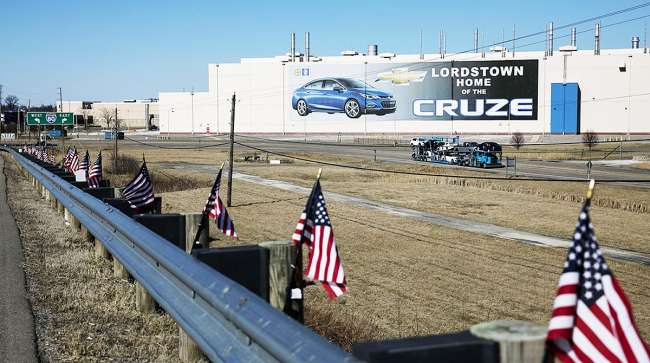GM Strike Risk at 12-Year High With Weekend Deadline Approaching

[Stay on top of transportation news: Get TTNews in your inbox.]
Union leaders from General Motors Co. factories across the country are flying into Detroit this weekend to either agree to take a proposed labor contract offered by the automaker to their members for a vote, or go on strike.
For United Auto Workers union rank-and-file emboldened by a U.S. president who has criticized the company for closing plants and cutting workers, there are at least even odds for GM’s first walkout in a dozen years.
“It’s just difficult to see how both sides can come to an agreement,” said Kristen Dziczek, vice president of the industry and labor economics group at the Center for Automotive Research.

Over the past four years, American consumers bought record numbers of new vehicles and GM posted best-ever profits to match. The UAW wants a greater share in the spoils and to secure work for at least one of the four U.S. plants GM marked for closure last November. Management at the automaker, meanwhile, is bracing for a downturn and hardly in a mood for largesse.
“Union membership expectations are very high given how well GM has been performing,” Dziczek said. On a call with investors hosted by UBS Securities analysts this week, she said there’s a greater than 50% likelihood of a strike and risk that the production halt could last several weeks.
UAW spokesman Brian Rothenberg said it is premature to speculate on the likelihood of a strike. GM’s goal is to continue having constructive discussions with the UAW on reaching an agreement, company spokesman David Barnas said.
GM and the UAW’s current four-year labor pact expires Sept. 14 at midnight. If the sides reach a tentative agreement, leaders from locals around the U.S. will be briefed, then hold elections at union halls to decide on ratification. If union negotiators don’t like GM’s offer in this round of talks — the first headed by UAW President Gary Jones — they could either agree to an extension or call for a walkout.
The UAW last called a strike on GM in 2007, though it lasted just two days. Earlier this month, the union said 96.4% of GM members voted in favor of authorizing a strike. Jones called this a “key tool in the tool belt” for his negotiating team.
“It is a real possibility that the UAW could strike GM if a tentative agreement cannot be reached,” Tim Stannard, president of UAW Local 1853 in Spring Hill, Tenn., wrote to members this month. The union boosted weekly strike pay in March.
A deal with GM will set a precedent for wages, benefits and other matters that the UAW will use to set a pattern for similar deals with Ford Motor Co. and Fiat Chrysler Automobiles NV.
Major sticking points for the UAW include limiting the number of temporary workers GM is allowed to use, giving new hires a quicker route to making senior-level wages of more than $30 an hour and securing work for some of the plants in Michigan, Ohio and Maryland that GM hasn’t allocated future product to, said two people briefed on the union’s priorities.
The union also wants to secure a cost of living allowance that would help offset any inflation over the course of the agreement, the people said.
The UAW is furious over GM’s decision to idle the Chevrolet Cruze compact car plant in Lordstown, Ohio, and schedule the end of production at another factory in Hamtramck, near Detroit, for January. Two transmission plants — one in a Detroit suburb and another near Baltimore — have shut down.

(Jeff Kowalsky/Bloomberg News)
President Donald Trump has weighed in by publicly calling for Mary Barra, CEO of GM, to open the Lordstown plant or sell it. While he praised Barra in May for efforts to sell the facility to financially troubled electric-truck maker Workhorse Group Inc., he went back on the attack last month, then hosted the CEO in the White House last week.
Terry Dittes, the UAW’s top negotiator with GM, has told union local leaders that getting products for the Lordstown and Hamtramck plants is a big priority, one of the sources said.
The problem is that last year, GM had about 1 million vehicles worth of U.S. production capacity that went unused, according to researcher LMC Automotive. Closing Lordstown addressed about one-third of that excess, but unless GM can boost utilization by adding new models or improving sales of existing vehicles, more production needs to go, said Ron Harbour, a senior partner for consultant Oliver Wyman.
Since many Lordstown workers have transferred to GM plants in Indiana, Kentucky, Michigan, Missouri and Texas, and GM is working on a deal to offload the facility to Workhorse, it appears less likely to be allocated a new vehicle than Hamtramck.
On the other side of the negotiating table, GM wants to be able to use more temporary workers.
About 7% of GM’s union staff, on average, are temps the company can more easily dismiss in a downturn than full-time workers. Temps also get paid as little as $15 an hour, about half the wage of the automaker’s senior factory hands.
The UAW wants to reduce the number of temps as a means to boost membership of full-time workers, Dziczek said. The union may even push to establish a path to permanent employment. Right now, even temps that have worked at a GM plant for several years must apply like an outside worker to get the job, she said.
Adding further tension is the federal investigation into corruption among union leaders. Senior staff at the UAW and Fiat Chrysler have been sentenced for taking money from a union training fund in a case that may have compromised their 2015 labor agreement. Last month, the government alleged corruption at the UAW-GM training center and charged a former union official with wire fraud and money laundering.
FBI agents raided the homes of Jones, his predecessor Dennis Williams, and other union officials last month.
With such a cloud hanging over UAW leadership, they may feel compelled to drive a tougher bargain, said Harley Shaiken, a labor relations professor at the University of California-Berkeley.
“Many members are angry and turned-off,” Shaiken said. “It adds to an already difficult set of negotiations.”




